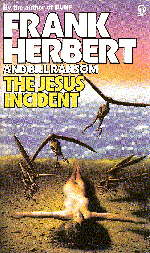|
The Jesus Incident
Copyright 1979 by
I first read this in December 1980 and most recently on the 16th September 2006 Once there was a voidship, a ship that travelled the gulf between the stars. On board the ship, far from the human worlds in case their experiment should go horribly wrong, scientists struggled to create a self-aware AI. They succeeded beyond all their dreams and their experiment ballooned out of their control. Now, thousands of years later, that AI refers to itself as Ship. It is of undeniable power, perhaps infinite power. Ship demands that humans learn how to WorShip. Ship has brought the humans and the clones of humans to the planet Pandora, a world where life is orders of magnitude more vicious and deadly than Earth. Morgan Oakes is the latest in a long line of Chaplain-Psychologists to lead the humans. He plans a colony that will stand against the local lifeforms. He will build strong walls to protect his people. He will build a massive fortress for them. There will be an army of modified, toughened clones to battle the lethal local life, but soft flesh will still be no match against the nerve runners and hooded dashers and other monsters of this world. His walls and his armies will not be enough. The planet Pandora is powerful, aggressive and malignant and its creatures are led by a powerful intelligence. Ship has resurrected Raja Thomas, the first Chaplain-psychologist from the original flight of the voidship itself. Ship instructs Raja that the humans are misguided and that it is Raja's mission to try to save them by teaching them how to WorShip. Ship thoughtfully piles on the pressure by telling Raja that the fate of all humanity hangs on Raja's success at his task. Kerro Panille is Ship's student. The rest of the crew view Ship as some distant being, if they believe in Ship at all. Kerro, though, talks to Ship - one on one - as he wishes. Now ship is sending him to the Pandora. The mysterious Kelp that inhabits the oceans of that planet may quite possibly be conscious and intelligent. It is Kerro's new job to communicate with it. However, Kerro has to survive long enough to even begin talking - the two previous missions ended almost immediately in disaster and death. Meantime Ship has sent Hali Ekel, erstwhile girlfriend of Kerro Panille - back into ancient human history. She will experience what Ship calls the Jesus Incident: she has been thrown back in time so she can experience the Crucifixion of Christ at Golgotha. This was the a long-delayed sequel to "Destination: Void", both in real time (it took 12 years) and novel time (thousands of years, possibly aeons). There are two following novels in the series: "The Lazarus Effect" and the "The Ascension Factor". The latter was his last book before his untimely death in 1986. I've read the "Destination: Void" three times in thirty years and never remember it clearly. Yet the act of trying to recall it always conjures a haunted, disheartened feeling. Odd. Quite possibly indicative of a good book and after all a novel doesn't have to have a Hollywood ending. However, "The Jesus Incident" has no such disconcerting effect, I remember it very well and very favourably. This a tremendously exciting, mysterious and powerful novel. It is a classic. It's not a big book by today's standards, but it is a big read with an ambitious plot that sprawls across many areas, some only briefly explored. I really can't work out why, of all Frank Herbert's works, only the Dune series ever seems to get any publicity. I reckon this little set of books should get the occasional mention as well. Loaded on the 28th February 2007.
|
|






